In this article, I will unpack a hockey-specific training method you can use to light up the Men’s Leagues and become a legend in your playing circuit—without having to make crazy sacrifices in your professional or personal life.
When I’m hired to get a hockey player into the best shape of their life—to strip them of nearly all their body fat while adding functional muscle tissue at the same time—I have hundreds (maybe even thousands) of protocols in my toolkit that I can use to help them reach their goal.
However, if I’m given the added challenge of a quick deadline where I have a limited amount of time to give them that lean, high-performing physique, there’s only one type of training to use: advanced undulating periodization.
No, not the boring periodization methods you’ve read about in so many lifeless textbooks. I’m talking about real hockey-specific periodization and training methods that are on the cutting edge of performance enhancement.
I’ve taken the idea of undulating periodization to a whole new level and added in science-backed protocols throughout each workout to allow you to work on every hockey-specific training quality at once, rather than break them all up into different workouts/programs.
Do I have your attention yet? Let’s get into it.
Undulating Periodization for Hockey
First of all, wipe your memory of what you think periodization is: like focusing on one specific fitness quality (e.g. strength or hypertrophy) for months on end without ever changing the goal or workout program.
This is called “linear periodization,” and it’s something athletes used to use back in the day. Olympic athletes still use this method quite well; however, they also have four years to prepare for an event. So, if you have four years until your next hockey game, then I suppose you can discontinue reading this and move on to the next workout that you’ve repeated 400 times already.
But, if you want to train everything all at once so you can quickly improve your all-around game, then you need to switch over to an undulating periodization method with some advanced hockey protocols thrown in.
So what exactly is undulating periodization? Put very simply, undulating periodization refers to using different loads, reps, and sets in a resistance training program that changes every week. The purpose behind undulating periodization is to get your body to respond to a variety of different challenges rather than focusing on only one challenge at a time.
Think about it like a dance routine: instead of just working on your footwork for six months straight, I am instead challenging you to rehearse multiple aspects of the dance performance all at once in a methodical manner without overtraining you or burning you out.
This leads to faster progress in multiple different areas all at once—not to mention the significant psychological benefit achieved from having a fun training program that changes often and has you doing many different things. This keeps you motivated in your training and helps you avoid the common boredom that comes with more linear methods.
As part of the Beer League Blueprint I have prepared for you today, you will be utilizing an undulating method for all of your “main lifts” in the gym, so that each and every week you have a new challenge to conquer.
Advanced Hockey Training Methods
I’ve taken the concept of using specific protocols within your hockey training program and ramped it up.
Instead of training only one aspect of the force-velocity curve, you will be training the entire force-velocity curve within every single training session.
Each workout will use the following:
- explosive speed movements
- undulating strength training
- intensity-specific drop sets
- muscle hypertrophy triplexes
- functional performance bi-plexes
- all-out anaerobic conditioning “finishers”
- active recovery-based mobility, injury prevention, and edge work enhancers
Each workout utilizes ten exercises that all fall on different areas of the force-velocity curve so you can train everything at once in a safe and effective manner. (Don’t worry, you don’t have to “get it” now. I’ll provide super simple examples in a moment.)
Fat Loss in the Beer Leagues
I understand the subtitle “fat loss in the beer leagues” is a hilarious oxymoron all by itself; however, it bears mentioning because this training protocol will create a powerful fat loss effect on your body.
Honestly, staying lean is one of the key characteristics that will allow you to light up the Men’s Leagues in legendary fashion all by itself.
Sure, you need skills as well. But being lean puts you way ahead of most people in the league, because many guys tend to “let themselves go” at this point in their life due to work, stress, and family commitments.
I would urge you to get on a training program that maximizes fat loss, because being lean has many benefits:
- Instantly improve your speed, because you will not be carrying around any non-functional weight.
- Instantly improve your conditioning, because you will maintain your strength at a lighter body weight, which will make each stride much easier and therefore less fatigue-producing.
- Improve your relative strength, which will create a dramatic effect on your explosive starting speed and first-step quickness.
- Reduce total body pain, as extra weight adds unnecessary impact stress on all of your body’s joint structures.
- Improve total body mobility due to better movement mechanics and less joint pain.
…among many other benefits that are self-explanatory in terms of both hockey performance and general health.
The training method I have put together for you creates a powerful metabolic effect that is incredible for fat loss, especially when combined with the Active Recovery Customization Method (ARC-Method) protocols that I support each individual program with (more on this in a bit).
For this epic fat loss to take place, you must pay keen attention to detail durings rest periods. You want them short enough to keep an elevated heart rate, but not so short that they decrease your performance in strength, power, or hypertrophy movements.
Don’t worry though: your longer rest periods will include an ARC-Method Protocol to keep you busy, and your fat loss will be further increased with the addition of an effective conditioning finisher found at the end of each training session.
These workouts are built for hockey performance, yet they drive insane fat-loss results. Why? Because explosive movements have a more profound effect on fat loss than slow movements.
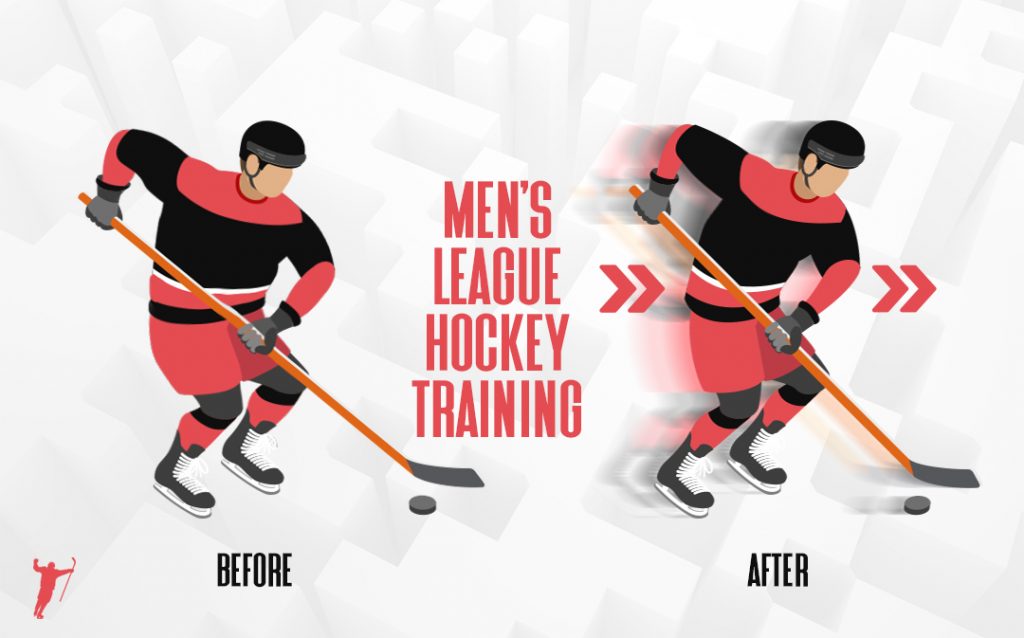
A workout that has both explosive movements and a strength-endurance complex (your “finisher”) all-in-one creates a convenient situation where you are maximizing fat loss results—but never at the expense of true hockey performance training.
And remember, the faster you can train without having a decrease in performance, the better. This is why we always respect our rest periods and use a stopwatch in the gym rather than try to “wing it” and hope you get what you desire out of your session.
Explosive work increases insulin sensitivity in the muscle tissue more than any other type of training. This helps you better partition all incoming nutrients within the six-hour post-workout window to lean tissue rather than to fatty tissue.
Having an array of explosive movements in your session sensitizes the muscle cells to insulin, which leads to less storage of fat from your dietary intake.
This is followed by a powerful increase in catecholamines that results in further energy expenditure and keeps the metabolic rate elevated for hours, even after you’re done the workout.
Finally, there’s the sheer calorie burn from performing big movements and your conditioning finishers. Your muscle is like an engine: the bigger it is the more gas you burn.
Big movements mean big calorie burn, and the combination of your undulating strength work, functional triplexes, and conditioning finishers check more boxes than we’ll ever need for fast physique transformation.
Five Star Workout Execution
I break up the workout in a logical progression across five different points of interest:
- Explosive speed
- Functional strength development
- Muscle hypertrophy triplexes
- Functional performance bi-plexes
- All-out conditioning finishers
Each workout using this blueprint targets all “five stars” of progression, and it does so in the exact order you see above.
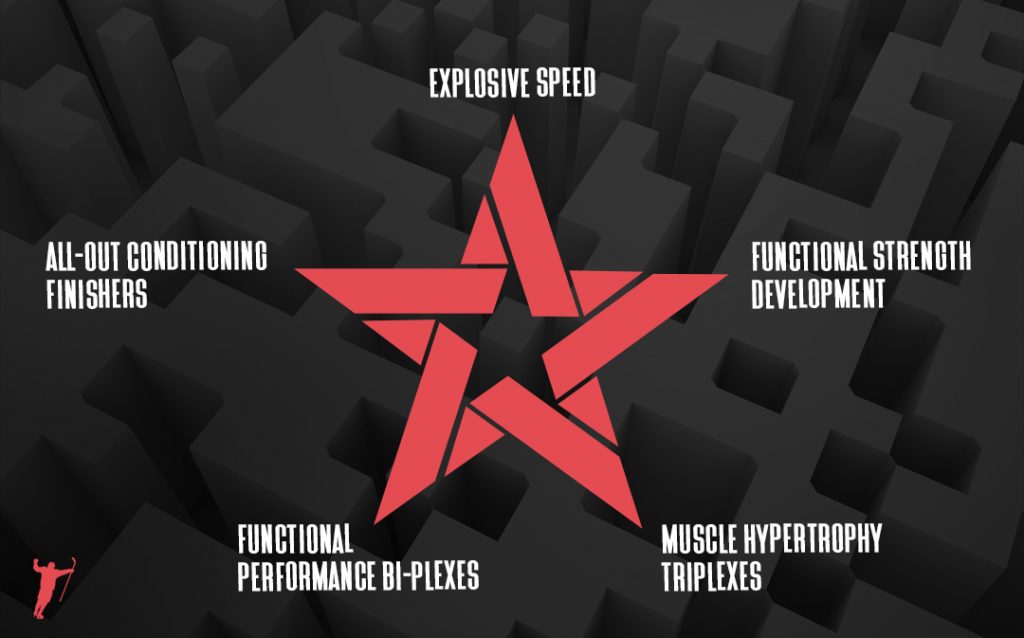
An example workout template for one day of the week would look exactly like the following, where “A” represents your speed work, “B” and “C” represent your strength work, “D” represents your hypertrophy work, “E” represents your functional performance work, and “F” represents your conditioning finishers:
A: Explosive speed movement
B: Undulating strength movement
C: Intensity-regulated drop set based off of undulated movement
D1: Muscle hypertrophy triplex
D2: Muscle hypertrophy triplex
D3: Muscle hypertrophy triplex
E1: Functional performance bi-plex
E2: Functional performance bi-plex
F1: All-out conditioning finisher
F2: All-out conditioning finisher
To make the workout as efficient for busy Men’s Leaguers schedules as possible, each session is a total body workout and therefore only needs to be performed three times per week and shouldn’t take longer than an hour to perform.
Using the above template will net you dramatic results in a very short timeframe. However, to really bring the “wow effect” to everybody out on the ice (including yourself), I recommend adding in some ARC-Method Protocols during the rest periods for both the “B” and “D” movements.
The Origin and Philosophy of the ARC-Method
The longer I work with high-performing men’s league hockey players, the smarter I am forced to become regarding the time they spend in the gym.
These hockey players often have much more going on in their life than just hockey. But they still want to be lean, strong, explosive, conditioned, agile, and dominate every aspect of the men’s league they compete in. Essentially, they want the results of a six-day per week program all packed into a three-day per week program so it would work better for their schedule.
To most, this would seem like a pipedream, but I took it as a challenge. After much head-scratching, I created what I now refer to as the ARC-Method.
It stands for the Active Recovery Customization Method, because it allows Men’s League hockey players to utilize movement quality drills to dramatically improve their hockey performance during what would previously have been just a “do nothing” rest period in between sets.
The best part is that it is completely customized to what the hockey player wants to focus on most, so they can squeeze every last ounce of optimization out of the time they spend in the gym. This allows them to reach all of their goals while simultaneously not letting “life” get in the way in them.
Here’s how it works: between sets intense enough to yield greater than 90 seconds of recommended rest, you will perform low-intensity movements to work on your weak points so you can increase your training volume in a way that won’t negate the purpose of your rest interval (i.e. these movements are not a “superset” and still allow you to recover and catch your breath between each set).
This also nearly doubles your training volume in an effective and hockey-specific way without spending any additional and unnecessary time in the gym, and allows you to self-select what you want to work on most so your exact needs are being met in the most time-efficient and energy-efficient way possible.
You already learned above that your base training structure uses an undulating periodization methodology that allows you to effectively train everything at once (speed/strength/conditioning etc.), rather than space it out over the course of several months (one month on speed, one month on conditioning, etc.)
Now when you combine an undulating periodization methodology with the ARC-Method in the same program, it’s as if you’re training everything at once while you’re training everything at once.
That’s not a typo: you’re training everything at once within your weekly split, and you’re also training everything at once within each workout structure.
It’s a double time-saving strategy for you, which also means it’s a double results-producing strategy.
How to Use the ARC-Method
Applying this method is simple. You only utilize the ARC-Method for exercises “B” and “D3” for every workout, because those are the only two areas where I recommend a 90-second or greater rest period.
I have protocols in my library that allow hockey players to focus on nearly any hockey performance quality during their rest periods. Ankle mobility/stability protocols, hip mobility/stability protocols, slap shot power, wrist shot power, fat loss accelerators, upper/lower body injury prevention, and core development protocols are all a part of my toolkit.
As an example, here’s what my “Lower Body Injury Prevention ARC-Protocol” is:
- Copenhagen side plank x 10 seconds per side
- Bodyweight split squats x 5–8 per side
These would simply be performed for one set each during your rest periods for movements “B” and “D,” so you could stay busy during your rest period and work on a performance characteristic that you need most.
I have the men’s leaguers choose their own protocols so that they can work on the exact protocol they need to work on their own weaknesses.
Many of them actually pick two different ARC-Method Protocols, since they can train them for the “B” and “D” movements each workout (for example, maybe you want to improve your edgework with an ARC-Method Protocol during the rest periods of exercise “B” so you went with an ankle stabilizing routine, but, you also know you need more core development so for exercise “D”s rest periods you perform the core development protocol).
To use this powerful technique though, you must do them properly:
- Do not “go hard” with them: remember, this is still a rest period.
- Do not add more than what I recommend.
- Do not perform them during any other rest period: only for exercises B and D3 throughout the duration of the entire program.
Essentially, keep things simple for yourself and don’t overcomplicate (or overwork) the process.
Perform the movements you selected at a pace where you could still hold a conversation without losing breath and you will be doing it perfectly. This may take a bit of practice, but you’ll find your groove pretty quick.
If you can do the above correctly while following my Five Star training format, you will be adding 5–10 sets of extra, recoverable training volume per workout.
This equates to 15–30 sets per week, 60–120 sets per month, and 360–720 sets across a full six-month program.
The fact that this extra training volume doesn’t require any further time investment from you, will not overtrain you, and is also customized to your exact goals, makes the ARC-Method one of the most powerful tools I have ever invented in my entire career—and one of the most powerful tools you will ever use to dominate out on the ice.
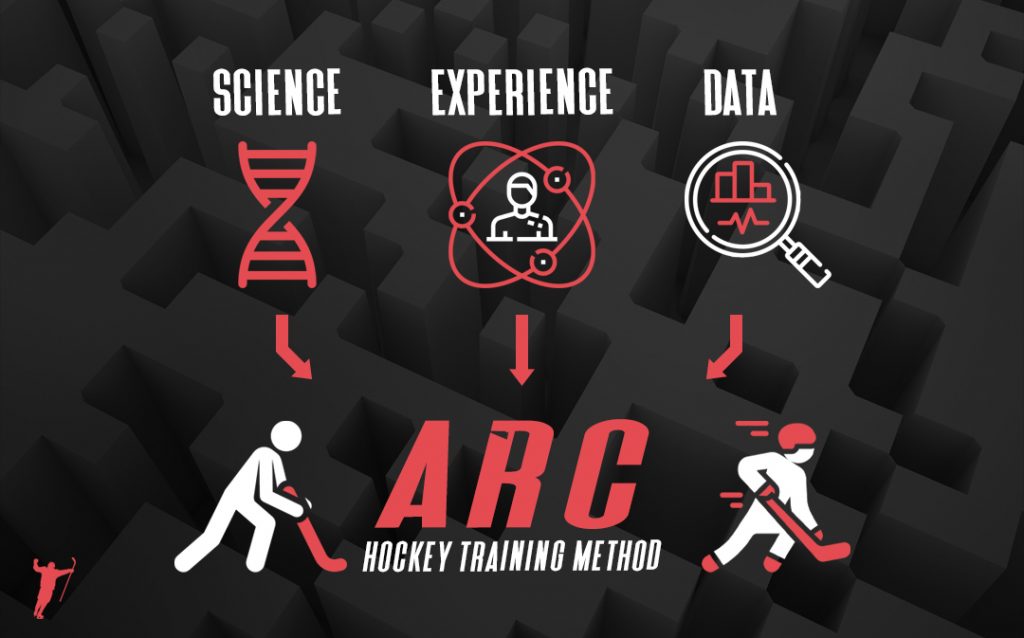
Example Workout – Gym Version
A: Skater bounds: 3 x 2 per leg [60 secs rest]
B: Bent over two-arm DB row: 7 x 3 [120 secs rest] *Optional ARC-Method Protocol
C: Bent over two-arm DB row with 30% of your bodyweight in each hand: 1 x AMRAP
D1: DB squat-curl-press: 3 x 10 [0 secs rest]
D2: Kettlebell swing: 3 x 10 [0 secs rest]
D3: Close grip push ups: 3 x 20 [90 secs rest] *Optional ARC-Method Protocol
E1: Cossack squat: 3 x 8 per leg [0 secs rest]
E2: Crossover step up: 3 x 8 per leg [60 secs rest]
F1: Bear crawl: 8 x 20 feet [0 secs rest]
F2: Side plank: 8 x 20 secs per side [0 secs rest]
What Kind of Results Can You Expect?
I’ve seen nothing short of dramatic results time and time again.
I’ve seen elite hockey players drop upwards of 5% body fat in one month while following this protocol—without altering their nutritional intake.
I’ve heard Men’s Leaguers tell me they wish they would have had access to something like this years ago, because they are skating even faster now than they did in their teen years.
And I’ve seen experienced trainees completely revamp their body composition in less than eight weeks while adding up to 20% strength in their main lifts.
This programming structure works for any body type, any goal, any training experience, and any “life schedule” you might be currently going through.
It is that powerful.
It’s one of my best kept coaching “secrets”—and now, the secret is all yours with the brand new Men’s League Domination ’21 system.
If you’re serious about becoming a better hockey player this year and you want to take your abilities to the next level, then pay very close attention, because starting today you can be one step closer to becoming a star player.
You don’t have to be a “natural talent” to instantly up your game and have the best season of your life this year—because you can get instant access to the exact program you need to maximize your potential.
Look, I know playing in the Men’s Leagues is all about having fun, but, it’s a lot easier to have fun when you’re dominating on the ice and reaching every goal that you set for yourself.
Sure, you could go through all the research studies I have read and slowly piece everything together everything I laid out above and you’d probably do just fine…but, if you want to take all of the guesswork out of it and get access to a completely “done for you” high-level program to get the best possible results, then check out the brand new Men’s League Domination ’21 system and let’s get started today: https://www.hockeytraining.com/mld21-system/
Lean on my experience of working with thousands of hockey players (including NHL players) and discover what you need to do in order to be your absolute best on the ice.
The Men’s League Domination ’21 system includes a full gym version, a home gym version, and a bodyweight-only version, so no matter what life throws at you, you will always have a go-to performance booster to keep your progression rates linear.
Not to mention, the program can be successfully run for one full year of programming, so you can expect insane results using these methods.
Unstoppable speed, edge work, conditioning, and agility can all be a reality for you this year; join the team here and let’s crush this thing.




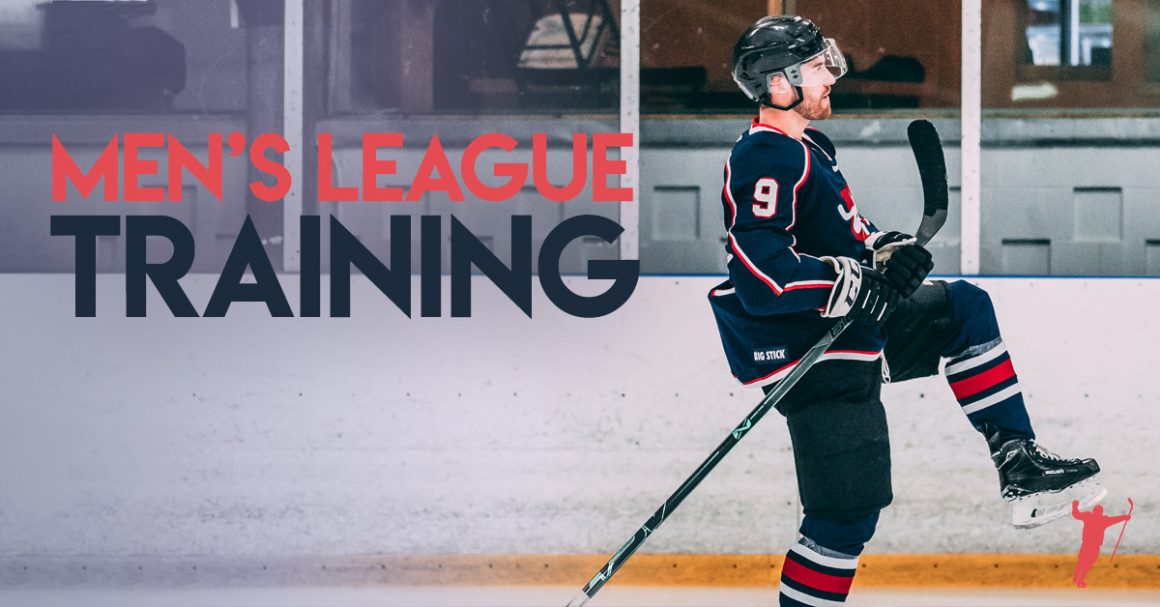

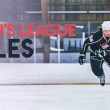



I have a question regarding the “A: Skater bounds: 3 x 2 per leg [60 secs rest]” example.
So three jumps per leg, two sets with 60 secs rest in between?
Any reason it’s only three jumps? It seems like one can manage a few more jumps perhaps.
Thanks!
/Chris
Hey Christopher,
That actually represents 3 sets of 2/leg, not 2 sets of 3/leg.
The purpose of using this set/rep/rest scheme is because we are training explosive power at the beginning at the workout, not conditioning. Just because you can do more doesn’t mean it’s the right thing to do.
Speed is how fast you can do something, conditioning is how long you can do something.
In order to properly train speed you need to achieve all-out velocities on every rep and complete nervous system recovery in between sets. Save the higher rep lower rest work for later where it’s better placed (at the end of the workout).
For more information on properly training explosive speed and power, check this out: http://www.hockeytraining.com/speed
I always enjoy your work coach. You have a gift for being a visionary as well as an ability to communicate in an entertaining way. It seems as though I can always identify experiences in my own training with those you describe. I have been a fitness instructor for over 20 years and I haven’t come across anybody on your level in terms of solving established problems in innovative and constructive ways. Just wanted to thank you for all you’ve done, keep the articles coming.
Thank you! 🙏👊
Can you comment on how these workouts are intended to work with your existing hockey schedule? If you’re playing a game that day, should you push the workout back 1 day? If you can’t currently play hockey due to Covid restrictions, should you add more workouts in a week?
Hey Eric,
I don’t recommend performing one of these workouts within two days of a game due to the intensity level. If it’s the day of a game or the day before, active recovery work such as mobility circuits, hockey yoga, or very light cardio are recommended.
Also, whether you’re playing hockey or not right now, the workout breakdown above would still only be performed 3x per week because it was designed to cover everything for you in only three days no matter what’s going on.
However, you can add-in different workouts such as extra speed or conditioning sessions each week if you have the extra time — I provide the extra workouts inside the member’s area for Men’s League Domination ’21, or, there are some great add-in options over at HockeyTraining.TV as well that go great with this system.